Products:
- Bushnell Elite Tactical 4.5-18×44 FFP IL
- Bushnell Elite Tactical DMR II 3.5-21×50 FFP
- Bushnell Elite Tactical DMR II 3.5-21×50 FFP IL
- Bushnell Elite Tactical XRS II 4.5-30×50
- Bushnell Elite Tactical 4.5-18×44 FFP
- Bushnell Elite Tactical SMRS II 1-6.5×24
- Bushnell Elite Tactical SMRS II Pro 1-6.5×24 ILL
- Bushnell Elite Tactical DMR II Pro 3.5-21×50
Congratulationsonyour choiceofa Bushnell® Elite® riflescope. It isaprecisioninstrument constructed of the finest materials and assembled by highly skilled craftsmen for a lifetime of trouble-free use under the most demanding conditions.
This booklet will help you achieve optimum performance by explaining how to use its various features and how to care for it. Read the instructions carefully before mounting and using your scope.
The accompanying photographs are guides to the nomenclature and location of the riflescope parts mentioned throughout this text.
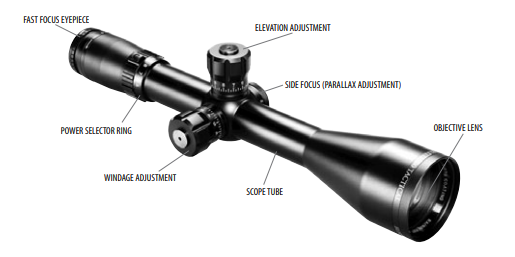
RAINGUARD® HD
This new technology gives you a significant improvement in brightness and light transmission and provides unequaled clarity in the worst conditions. RAINGUARD® HD is the first coating to protect your riflescope
against external fogging. Has your scope ever fogged on a cold day because you accidently breathed on your eyepiece? Have you ever hunted on a cold, wet day and found it almost impossible to keep the outside of your scope from fogging? RAINGUARD® HD will help prevent these problems.
HOW IT WORKS
RAINGUARD® HD is a special water repellant coating on which condensation forms in much smaller droplets than on standard coatings. These droplets form when the scope is exposed to rain, fog or snow. These
smaller droplets scatter much less light than the larger droplets on other coatings. This results in a much clearer and more useable sight picture. Additionally, water sheets off RAINGUARD® HD much more readily
than a standard coating. For the first time, the hunter will not miss the shot of a lifetime because moisture was on the lens.
CARE OF RAINGUARD® HD
RAINGUARD® HD is an extremely durable, scratch-resistant, permanent coating that will give you years of service. To get the best performance, just keep the lenses clean. To clean, first blow away any dirt and dust or use a soft lens brush. Fingerprints and lubricants can be wiped off with lens tissue or a soft, clean cotton cloth moistened with lens cleaning fluid.
EYEPIECE FOCUSING
This adjusts the focus so that the reticle (cross hairs) appears sharp to your eyes. All Bushnell riflescopes are focused at the factory for 20/20 or corrected vision. If the reticle appears sharp, no adjustment is needed. If the reticle appears unsharp, adjust as follows:
The eyepiece is designed to provide a precise fast focus. Simply look at a distant object for several seconds without using your scope. Then, shift your vision quickly, looking though the scope at a plain background. Turn the fast-focus eyepiece clockwise or counter clockwise until the reticle pattern is sharp and clear.
WARNING: Never look at the sun through the riflescope (or any other optical instrument). It may permanently damage your eye.
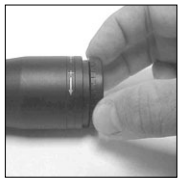
MOUNTING
To achieve the best accuracy from your rifle, your Bushnell scope must be mounted properly. (We strongly recommend that those unfamiliar with proper procedures have the scope mounted by a qualified gunsmith). Should you decide to mount it yourself:
1. Use a high-quality mount with bases designed to fit your particular rifle. The scope should be mounted as low as possible without touching either the barrel or the receiver.
2. Carefully follow the instructions packed with the scope mounts you have selected.
3. Before tightening the mount rings, look through the scope in your normal shooting position. Adjust the scope (either forward or backward) until you find the furthest point forward (to insure maximum eye relief) that allows you to see a full field of view.
WARNING: If the scope is not mounted far enough forward, its rearward motion may injure the shooter when the rifles recoils.
4. Rotate the scope in the rings until the reticle pattern is perpendicular to the bore and the elevation adjustment is on top.
5. Tighten the mounting screws as tight as possible.
VARIABLE POWER ADJUSTMENTS
To change magnification, simply rotate the Power Selector Ring to align the desired number on the power scale with the Index Dot. When still-hunting or stalking game, a variable scope should be set to the lowest
power. You then have the widest field of view for quick shots at close range. Higher powers should be reserved for precise long-range shots.
WARNING: A scope should never be used as a substitute for either a binocular or spotting scope. It may result in your inadvertently pointing the gun at another person.
ELEVATION AND WINDAGE ADJUSTMENT
Your Bushnell® Elite® scope features finger-adjustable, audible-click elevation and windage adjustment turrets. Grasp the Adjustment Turret and turn it in the appropriate “UP” (and/or “R”) direction indicated
by the arrows. Each “click” or increment on the Adjustment Scale Ring will change the bullet impact by 1/4″ Minute of Angle or 0.1 Mil (depending on your scope model). See scope adjustment dial for the click
adjustment value on your scope. 1/4 MOA corresponds to 1/4 inch at 100 yards, 1/2 inch at 200 yards, 3/4 inch at 300 yards and so on.
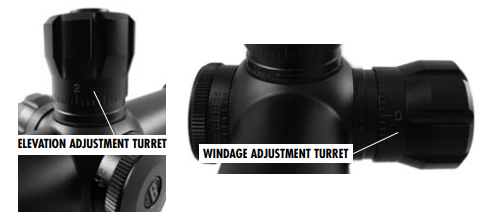
BORE SIGHTING
Bore sighting is a preliminary procedure to achieve proper alignment of the scope with the rifle bore. It is best done using a Bushnell Bore Sighter. If a bore sighter is not available, it can be done as follows:
Remove the bolt and sight through the gun barrel at a 100 yard target. Then sight through the scope and bring the crosshairs to the same point on the target. Certain mounts have integral windage adjustments and, when bore sighting, these should be used instead of the scope’s internal adjustments. If major elevation adjustments are needed, they should be accomplished by shimming the mount base.
ZEROING
Final sighting-inof your rifle should be done withlive ammunition, basedonyour expected shootingdistance. If most of your shots will be at short range, zero-in at 100 yards. But, for long-range shooting at big game, most experienced shooters zero-in about three inches high at 100 yards. Three-shot groups are useful for averaging the point of impact.
USING YOUR BUSHNELL TACTICAL RIFLESCOPE
Once you have finished sighting in your scope and your firearm is consistently on target, you may want to realign the zero marks on the windage and elevation dial scales with the index lines. To do this, first remove the target turret, then reset the dial to zero and replace the turret.
REMOVING THE TARGET TURRETS
Using the included Allen wrench (hex key), loosen the turret bolt (A) by turning it counter-clockwise while firmly holding the turret in place. You can either remove the bolt entirely (B), or just loosen it enough to be
able to pull up on the turret and rotate it freely in either direction (make sure the adjustment itself does not change-you don’t want to loose your zero setting).
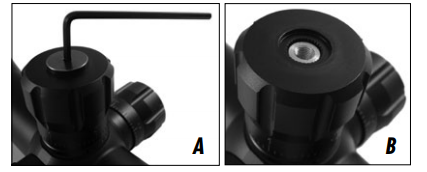
RESETTING THE DIALS TO ZERO
Once the turret bolt is loose (or removed), and you are able to pull up the elevation turret and rotate it freely, line up the “0” on the adjustment scale with the index line, then push the turret back down into place. Be careful not to lose any clicks when pushing the turret back down, which might affect your targeting at the next use. Replace the turret bolt and use the Allen wrench to tighten it (turn clockwise) until the turret is
securely in place. Repeat this process with the windage turret.
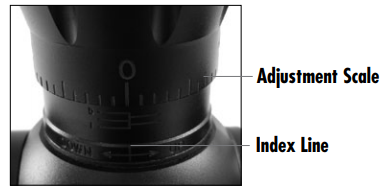
USING THE SIDE FOCUS CONTROL (ADJUSTING FOR PARALLAX)
You may have noticed that placing your eye at different positions behind the scope’s eyepiece causes the reticle crosshairs to appear to move around to different points on your target. This is called “parallax error” (target and reticle are not in the same focal plane), and it becomes more noticeable (and more of a problem) at shorter distances and/or when the scope is set to higher powers. Your tactical riflescope provides an adjustment for parallax compensation, which works by moving an optical element until the target (based on its distance) appears in the same plane of focus as the reticle. Instead of the typical parallax compensation design which adjusts the objective lens at the front of the scope (“adjustable objective” or “AO”), your scope uses an movable lens back near the reticle, so the adjustment can be more easily made with a “side focus” knob placed next to the windage and elevation adjustments. Just line up the estimated distance (on the side focus dial- you may want to use the mil dot reticle to range it first) to your target with the index line on the body of the scope, and you will eliminate the aiming errors caused by parallax. After setting the side focus, you can double check by moving your head around from side to side behind the eyepiece-the point of aim should not shift if the side focus is correctly set. An alternative method is to look through the scope and turn the Objective Adjustment Ring until the target, at whatever range, is sharply focused.
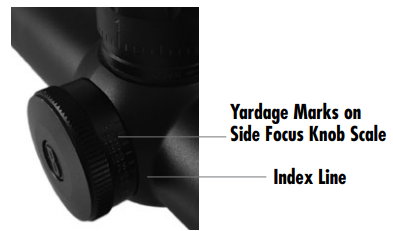
ABOUT RETICLE FOCAL PLANES
Variable power riflescopes may have their reticles located in either the first focal plane (in the section nearest to the objective lens), or in the second focal plane (nearer to the eyepiece or ocular lens). This
location determines how the reticle will behave relative to the target when you change the scope’s power (magnification).
If your scope’s reticle is located in the first focal plane, the size of the reticle will appear to increase or decrease when you increase or decrease the scope’s power (using the zoom ring), just as the target itself does. If the reticle is in the second focal plane, the reticle always appears at a constant size and does not follow your changes in power-only the apparent size of the target changes.
This is especially significant in riflescopes with mil dot or other range estimation type reticles. A first focal plane reticle may be more convenient, as it allows you to use the guide marks at any power you select. A second focal plane reticle can only be used for range estimation at a single power setting, the one it has been calibrated for (unless you do a little math, as described later in this manual). You can of course use the scope crosshairs at any power for accurate shooting-however you will only get accurate distance estimation by using the ranging marks at the calibrated magnification.
USING MIL DOT RETICLES
Your Bushnell Tactical riflescope contains a mil-dot reticle (1st or 2nd focal plane, depending on the model), the most accurate means of range estimation using a manual optical device. These mil dots also allow precise leads for moving targets and exact compensation for shooting in a crosswind.
RETICLE DESCRIPTION
The middle of this reticle contains four evenly spaced mil-dots arrayed outward vertically and horizontally from the center. Actually, because the very center dot was left out to allow clear aiming, the reticle represents five mils in any direction – ten vertical mils – as shown in the illustration. Note that the most outward dot is replaced by the edge of the heavier reticle line.
One mil is the space from center-dot to center-dot. One-half and one-quarter mils are easy to estimate mentally; with practice, you can measure tenths of mils for the most exact ranging.
RANGING WITH YOUR MIL-DOT RETICLE
The mil is an angular measurement – 1/6400th of a circle – which equals almost precisely one yard at 1000 yards, or one meter at 1000 meters. This proportional relationship makes possible a simple formula
to compute distances:

This formula works equally well with meters, but don’t mix meters and yards: Measure the object in yards to find the distance in yards, use meters to yield distances in meters.
Looking through your scope (if yours has a 2nd focal plane reticle, be sure to set it on the synchronized magnification setting-marked in red or white), select an object at the distance you want to range – an object whose width or height you know or can estimate accurately. Man-made objects of uniform size, such as fenceposts, are best, but any object of known dimensions will do. Measure the object’s height or width carefully in mils, compute it according to the formula and you will find its range. Support your rifle and be precise when measuring objects; any measuring error causes an error in the computed range. Equally, a mistake in estimating the object size results in a proportional range error
Here’s an example: A coyote is sunning himself in a snowfield beside a fencepost; having crossed the fence earlier, you know that the post is four feet high, or 1.33 yards. The fencepost measures 2.5 mils in your reticle.

If you have a variable power scope with a 2nd focal plane reticle (the reticle stays the same size regardless of magnification), it must be set at the calibrated power mark to synchronize the mil-dot size for ranging.
But you also can range at half that power if you divide the range estimate in half, or at double the calibrated power, by doubling the range estimate, as shown in the next section (using as an example a 2nd focal plane reticle with a calibrated (synchronized) setting of 12x power):
CALCULATING HOLDS FOR WIND AND MOVING TARGETS
Your horizontal mil dots provide a precise way of holding for crosswinds and target movement. Just look in your cartridge’s wind drift and moving target tables to determine the exact holds for different distances. The accompanying table lists one-mil widths from 100 to 600 yards, so you can calculate how many mils to hold right or left when firing in a crosswind, or engaging a moving target.
MIL WIDTH FOR WIND AND MOVING TARGET LEADS
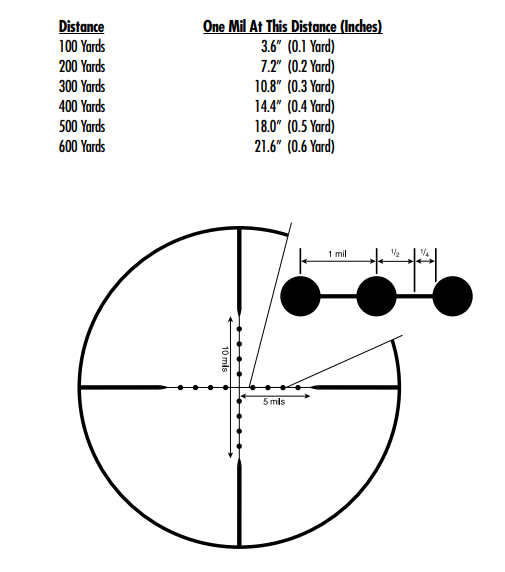
One mil is the distance between centers of dots. It’s easy to measure in half-mils or even quarter-mils but with practice you can measure tenths of a mil.
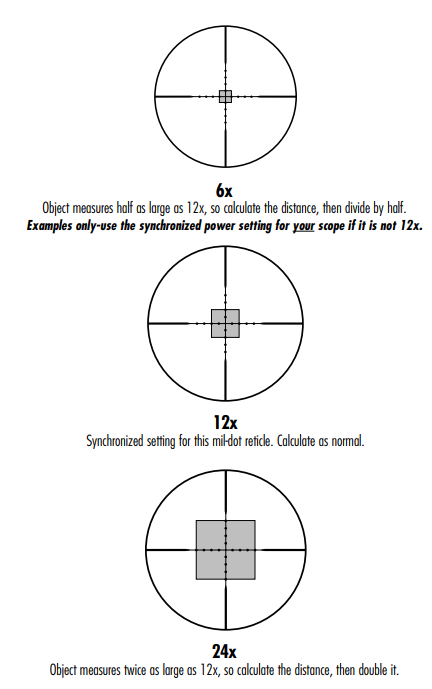
MAINTENANCE
Your Bushnell Elite riflescope, though amazingly tough, is a precision instrument that deserves reasonably cautious care.
1. When cleaning the lenses, first blow away any dry dirt and dust, or use a soft lens brush. Fingerprints and lubricants can be wiped off with lens tissue, or a soft clean cloth, moistened with lens cleaning fluid.
WARNING: Unnecessary rubbing or use of a course cloth may cause permanent damage to the lens coatings.
2. All moving parts of the scope are permanently lubricated. Do not try to lubricate them.
3. No maintenance is needed on the scope’s outer surface, except to occasionally wipe off dirt or fingerprints with a soft cloth.
4. Use lens covers whenever it is convenient.
STORAGE
Avoid storing the scope in hot places, such as the passenger compartment of a vehicle on a hot day. The high temperature could adversely affect the lubricants and sealants. A vehicle’s trunk, a gun cabinet or a closet is preferable. Never leave the scope where direct sunlight can enter either the objective or the eyepiece lens. Damage may result from the concentration (burning glass effect) of the sun’s rays.
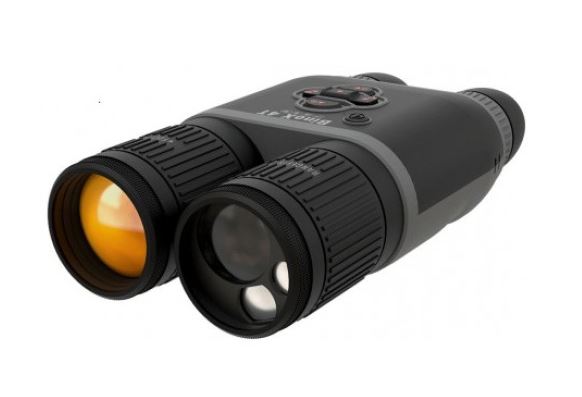
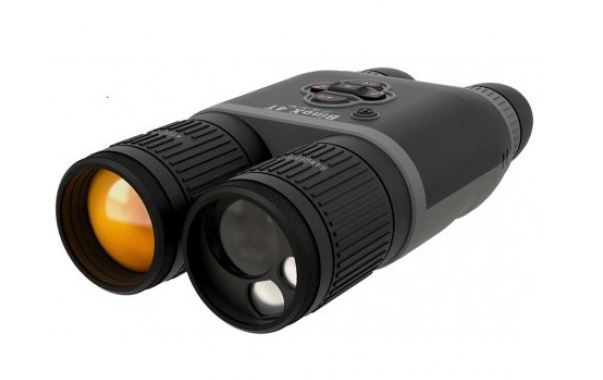



My 4.5 x30 x50 busnell tactical elite up an down is not in the center of the turret it’s a half more or less on the numbers between the no